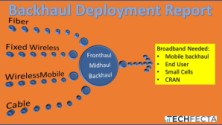Weather Related Issues
When working in wireless, many things can create work and delay work. Weather is a big one because you have no control over it, yet it has control over you.
The recent tornadoes and hurricanes have made the workload extremely busy. Especially in Puerto Rico where the hurricane wiped out most of the country.
For a list of products to support Wade4Wireless, click here!
These issues have caused the carrier to spend a fortune to repair and rebuild. It’s good for many people in the industry because they get work that was unexpected, like repairing destroyed antennas, base stations, and so on. We do what we can to make the repair and/or replace the equipment. Larger OEMs are very slow, but they do what they can to respond.
If you’re bidding on work, this can be a problem. I was bidding on an expansion in Puerto Rico right before the hurricane hit. That stopped everything, and it made the contractors think they could get a premium for the work. For one, everyone pointed to the hurricane and added insane risk values to the work. They said any hurricane is a risk. Well, when the hurricane hit, nobody got the work because the expansion was called off so that repairs from the hurricane could happen. That drained the expansion fund. My point is, everyone knew that hurricanes hit and tried to cover for it when in reality the hurricane fund is a different fund. You have to be realistic when planning a deployment versus damage repair. Completely different business models.
Weather invokes risk. Everyone wants to charge for that risk, but those days are gone. You have to deal with it somehow, but it can’t be through charging the customer. They won’t pay for a potential risk unless it is authentic. I think we need to find the balance and try to work together. The risk from weather has to be taken seriously, but you can’t let it stop the work altogether. I have seen people pull out of bids on a potential weather risk alone. I get it, something terrible could happen, but that’s why it’s called a risk. If the probability is high, then the customer will understand. Many times, we can wait and see or delay, again, that is a cost, but one that both parties can bare.
If the system is built and a hurricane, flood, or tornado happen, then you need to respond in a timely fashion if you get the work. Generally, this is maintenance and not bid out, but who knows how carriers will handle it going forward.
Then there are the less obvious weather problems like lightning. Yes, lightning can still take out a site. We are better protected than ever, yet it still happens.
What can you do?
- Plan the deployment around the better seasons. Good luck, but it may help, the weather is bad all year round, but worse during some seasons than Northeast has winter blizzards; Southeast has summer hurricanes, Midwest has sprint tornadoes, the west has summer heat waves. Maybe the fall is the best time, but fall brings rain and high winds.
- Make a contingency plan. If a storm or hurricane is rolling in, stand down for a week or two. If a tornado hits, then wait it out for a few days. If a blizzard is coming, stay away for a week. The weatherman is your friend; even if he is wrong, you could play it safe.

- You get hit unexpectedly with lousy weather, deal with it, it will be a loss. It’s best to build in some risk into your business plan. If you can make up time somewhere else or get ahead of schedule, then use that time to pay for the losses you’re incurring now.
- Add some money into a severe weather risk fund. Plan ahead to cover yourself for times like this.
Manpower shortages
There will always be an issue with manpower. A shortage of manpower creates risks that vary from deployment delays to price gauging. Both are potential problems when there is a shortage of crews. With the deployments ramping up and the manpower being called in, you have to prepare for the issues that happen with a heavy workload.
What can you do?
- Put in place a hiring and training program that makes sense. This allows you to ramp up quickly and efficiently with a well-implemented program instead of trying to figure out what to when it’s too late.
- Partner with other companies to cover you in the bad times. Be willing to hire the competition when you need help.

- Call back laid-off workers in good standing. Some burn bridges, but if you need people and they are trained, then ask them to help out.
- See if a 1099 work plan will help out to get you through the tough times. Maybe someday they can go W4, but for now, get them in to help out as 1099, if that works in your model.
- If you lay off when it’s slow, let them know why that you’re out of work. Don’t just let them go and burn the bridge. Let them know that the door may open up again. Don’t be an asshole, be a responsible manager.
- Call people back that retired! They could help you train and get the crews up and running quickly. They are a valuable resource that most companies overlook.
- Let the customer know that resources are scarce and that the schedule will suffer. Let them know ASAP, just in case you can’t keep up. Honesty really is the best policy, even if it hurts now, it may save you later, and the customer should appreciate your honesty. This may help you get more help through the customer.
Equipment shortages
This all too common. The equipment could be anything, so let’s look at some scenarios.
OEM/manufacturer specific equipment
This could be a computer, server, transmitter, or even a specific cabinet. These are all things that we rely on a specific OEM or manufacturer to  deploy. This could be a power supply or a cabinet. While for the small business they would just find a replacement, if you’re dealing with a carrier, they would have to have it tested and approved before they would deploy anything. This is a 3 to 6-month process. It’s not easy when you’re trying to be compliant.
deploy. This could be a power supply or a cabinet. While for the small business they would just find a replacement, if you’re dealing with a carrier, they would have to have it tested and approved before they would deploy anything. This is a 3 to 6-month process. It’s not easy when you’re trying to be compliant.
Cable shortages
This is more common than you know. In today’s carrier world where they specify the specific manufacturer, supplier, and type of cable. If you ever worked with a hybrid flex cable, then you know what I mean. It has a specific power cable, fibers, and so on. Each manufacturer has a specific requirement. These supply issues can cause problems.
Shipping issues
This could be any of the equipment above. Shipping can be an issue. If something comes from within the USA, it’s generally not a shipping problem. Maybe supply, but not shipping. However, how much equipment actually comes from the USA? We get most everything from China. It takes time to get something from China. The outsourcing is a problem. We have to get everything over here quickly, but then it has to go through customs. It’s a real problem and one that I don’t see being resolved any time soon.
What can you do? Not much if it’s coming from China, sit and wait.
Common equipment shortages
This could be jumper cables like fiber jumper, copper jumpers, or maybe even coax. When everyone is doing their deployments at the same time, then you have shortages from vendors and suppliers that didn’t plan well or have been burned in the past.
What can you do?
- Have plenty of suppliers!
- Get a list of approved alternates you can use at the start of the project. While this sounds easy and obvious, it’s generally the last thing you think about when starting to deploy.
- Create your own stock. This is a risk because you may get stuck with something that could be scrapped early in the project. It takes your judgment to know if this is the right thing to do.
Design changes
The design of the equipment, installation, or even a process could change your profit margin. If you’re installing, then you may have to make a dramatic change when the equipment is altered. That will cost you more time. Of course, the customer won’t want to hear that.
The process could change, for instance, when you started installing all the equipment at the first site, you did it one way. Then things changed. At the tenth site, something changed in the process. The MOP changed because that specific equipment has to be installed differently for some reason. Suddenly, you slow down the installation because the process has changed. You need to figure out how to recover the cost of spending more time at the site. If you can’t recover the time, you have to ask for more money or walk off the job if it’s a huge loss. I have seen contractors do it. It’s not pretty for either side and causes a rift in the relationship.
What can you do?
- If the equipment changes, make a documented change in your process and track the time, document everything, then present it to the customer as a change order. Maybe you will have to alter the SOW or the contract. If you are going to lose money, you have to decide what to do. Hey, most large companies act like complete assholes when you ask for more money, but if you can document everything and build a case, it gives you a solid reason why. If you just ask for more money because you say it takes longer, think how that sounds to the other side. Documentation is the key. Build a solid case then show the change then present the new cost.
- If the process changes, document the time change and make a list of new costs. Document, then present the change in cost, then negotiate.
Unforeseen risks
This happens. It could be someone quitting, an accident at a site, a financial issue, anything. Then you need to deal with that. You could get fired because the customer wants to hire a relative or another company they like better or that works at half the cost you did. Sure, it sucks, but it happens. I have seen divorces destroy small companies.
What can you do? If you can make sure you have enough money to get you through the tough times. You may have to lay people off or work on having a backup project or customer. If you lost the business to someone else, then offer to work for them, but not at a loss!
Thank you for your support and your time. And good job on learning all you can in the wireless industry, you are amazing! Now, go out and impress people!
Do you want an occasional email with free PDFs of these reports along with book and training offers? Read posts like these offline!
Click here to sign up!
Be smart, be safe, and pay attention!
See Ya!
More products from TechFecta and Wade4Wireless that support WADE!
The foundations below do beautiful work, spreading love when all seems lost.
Climbers can get seriously injured and/or die on the job. Support the workers who build and install the wireless systems!
Together we can honor and remember the fallen in our wireless family.







 Putting together your smart city tech solutions, planning, development, and more…TechFecta! Guiding you to a better plan through consulting!
Putting together your smart city tech solutions, planning, development, and more…TechFecta! Guiding you to a better plan through consulting!
















